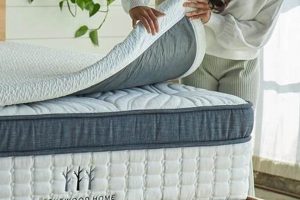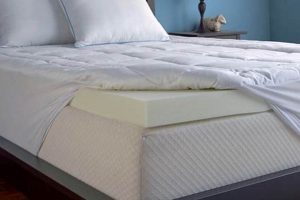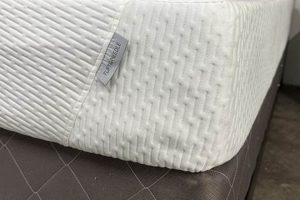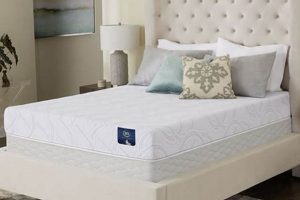The effective relocation of a specific type of bedding presents unique challenges due to its composition and flexibility. This bedding, designed for conforming support and pressure relief, often lacks the structural rigidity of traditional innerspring mattresses, requiring specialized techniques and precautions to ensure its safe and damage-free transport. The material’s density and ability to compress also influence the planning and execution of the moving process.
Proper handling is crucial to maintain the integrity of the item and prevent long-term damage. Neglecting established moving procedures can result in tearing, permanent deformation, or reduced comfort. Historically, moving such bedding involved simply folding it, which is now understood to be detrimental. Current best practices prioritize protecting its shape and ensuring even weight distribution during transit.
The following sections will detail the necessary materials, step-by-step instructions, and essential tips for successfully preparing, protecting, and transporting this type of mattress, minimizing the risk of damage and maximizing the ease of handling.
Relocation Strategies
Optimal strategies are required to facilitate the transport of this specific bedding type. Implementing these techniques minimizes risk and ensures the preservation of its structural integrity.
Tip 1: Acquire Appropriate Protective Covering: Securing a mattress bag designed for moving is essential. This safeguard shields against dirt, moisture, and potential tears during the relocation process. Ensure the bag is appropriately sized to accommodate the mattress without excessive slack.
Tip 2: Enlist Assistance: Due to the mattress’s weight and bulkiness, it is recommended to have at least two individuals involved in the moving process. This collaborative approach reduces strain and minimizes the risk of accidental drops or impacts.
Tip 3: Employ Proper Lifting Techniques: Lift with the legs, maintaining a straight back. Avoid twisting motions, which can lead to back injuries. Coordinate lifting and lowering with the assisting individual to ensure synchronized movement.
Tip 4: Secure the Mattress within the Moving Vehicle: Place the mattress flat, if space allows. If vertical positioning is necessary, secure it tightly against the vehicle’s wall using straps or ropes. This prevents shifting during transit, which could cause damage.
Tip 5: Utilize Furniture Sliders: On smooth surfaces, furniture sliders can significantly reduce the effort required to move the mattress. Position sliders beneath each corner to facilitate gliding across floors.
Tip 6: Avoid Bending or Folding: This material is designed to conform to the body’s shape; excessive bending or folding can cause permanent deformation or damage to the internal structure. Maintain its flat profile whenever possible.
Tip 7: Plan the Route: Prior to commencing the move, assess the path the mattress will take, identifying any potential obstacles, such as narrow doorways or staircases. Clear these obstacles to ensure a smooth and efficient move.
Implementing these strategies significantly increases the likelihood of a successful relocation, protecting the investment and ensuring continued comfort and support from the bedding.
The following section provides information on long-term storage considerations for this type of mattress.
1. Preparation
The efficacy of any attempt to relocate a conforming foam mattress is inextricably linked to the quality and thoroughness of the preparation phase. This stage is not merely a preliminary step, but rather a foundational element that directly influences the outcome. Deficient preparation can lead to avoidable damage, increased difficulty during the move, and potential physical strain for those involved. The cause-and-effect relationship is clear: inadequate preparation often results in negative consequences during the actual moving process. For instance, failing to procure a properly sized mattress bag can expose the foam to dirt, moisture, and tears, thereby compromising its structural integrity and hygiene.
The importance of preparation is further underscored by the nature of the mattress itself. Unlike rigid innerspring mattresses, memory foam conforms readily, which can make it unwieldy and difficult to handle if not properly secured. Example: acquiring straps for secure rolling and carrying. Without securing it, the weight can shift unexpectedly, causing difficulty and safety concerns. Proper preparation also includes assessing the moving route, identifying potential obstacles such as narrow doorways or staircases, and planning how to navigate these challenges. A carefully considered plan can prevent delays, reduce the risk of damage to the mattress or surrounding property, and minimize the physical exertion required.
In conclusion, diligent preparation is not simply a suggestion, but an essential component of successfully relocating a conforming foam mattress. It mitigates risks, optimizes efficiency, and ultimately safeguards the investment in the bedding. The challenges associated with moving this type of mattress are significantly reduced through proactive planning and the acquisition of necessary materials. Consequently, a well-prepared move translates to a smoother, safer, and more successful outcome.
2. Protection
The safeguarding of a conforming foam mattress during relocation is paramount to preserving its integrity and extending its lifespan. The inherent properties of the material make it susceptible to damage from various external factors, necessitating proactive protective measures. Without adequate shielding, the mattress may incur irreversible damage, impacting its comfort and support characteristics.
- Mattress Bags: Impermeable Barrier
Mattress bags constitute a primary defense against environmental contaminants. These bags, ideally constructed from durable, water-resistant materials, shield the mattress from dirt, dust, moisture, and potential infestations during transit. Example: A mattress transported without a bag may absorb moisture from the moving vehicle, leading to mold growth and material degradation. This demonstrates the necessity for a reliable barrier.
- Edge and Corner Guards: Structural Reinforcement
The edges and corners of a mattress are particularly vulnerable to impact damage during movement. Applying specialized edge and corner guards provides additional reinforcement, mitigating the risk of deformation or tearing. Example: Bumping a corner against a wall without protection could result in permanent compression of the foam, affecting the mattress’s structural integrity and comfort. Guard application prevents this damage.
- Padding and Blankets: Impact Absorptiontrong>
Wrapping the mattress in padding, such as moving blankets or bubble wrap, offers a buffer against shocks and vibrations encountered during transportation. This layer of protection minimizes the transmission of forces that could compromise the internal structure of the foam. Example: Sudden braking or uneven road surfaces can subject the mattress to significant stress. Padding distributes this force, reducing the potential for internal damage.
- Straps and Tie-Downs: Secure Immobilization
While seemingly unrelated to direct impact protection, the secure fastening of the mattress within the moving vehicle is crucial. Straps and tie-downs prevent shifting during transit, minimizing the risk of abrasion against other objects or the vehicle’s interior. Example: An unsecured mattress sliding against a truck bed during a turn can sustain significant surface damage. Secure immobilization prevents such movement and subsequent harm.
The aforementioned protective measures are integral to a successful mattress relocation. Their implementation ensures that the mattress arrives at its destination in a condition commensurate with its pre-move state, thereby safeguarding its value and functionality. By addressing the inherent vulnerabilities of the foam composition, these protective strategies contribute directly to the longevity and continued comfort of the bedding.
3. Technique
The employment of proper techniques during the relocation process is pivotal to mitigating potential damage and ensuring the efficient transport of a conforming foam mattress. Improper handling can lead to deformation, tearing, or other forms of structural compromise, negating the benefits of protective measures. The selection and execution of appropriate techniques are therefore crucial.
- Rolling and Compression
While outright folding is discouraged, strategic rolling can reduce the mattress’s overall dimensions for easier handling, particularly through narrow doorways. This must be done carefully, maintaining even compression to prevent localized stress points. The use of straps to secure the rolled mattress is essential to maintain its shape during transit. Inappropriate rolling or overly tight compression can damage the foam’s internal structure.
- Lifting and Carrying Posture
The mechanics of lifting and carrying a mattress are critical to both the mattress’s integrity and the movers’ physical well-being. Lifting should originate from the legs, maintaining a straight back to avoid strain. The mattress should be held close to the body to minimize leverage and maintain balance. A coordinated team lift, with clear communication and synchronized movements, is imperative. Failure to adhere to these principles can result in back injuries and/or damage to the mattress from dropping or mishandling.
- Navigating Obstacles
Moving a mattress through doorways, staircases, and hallways requires careful planning and execution. Assessing the path beforehand, identifying potential pinch points and obstructions, and developing a strategy to navigate them is crucial. Tilting the mattress at an angle, rotating it carefully, and using controlled movements are often necessary. Rushing or forcing the mattress through tight spaces can result in tears or damage to the surrounding property.
- Loading and Unloading
The process of loading the mattress into the moving vehicle and unloading it at the destination demands precision and control. The mattress should be lifted and placed gently, avoiding abrupt drops or impacts. Securing the mattress within the vehicle to prevent shifting during transit is paramount. A systematic approach to unloading, with clear communication and coordinated movements, minimizes the risk of damage and ensures a smooth transition.
These techniques, when implemented conscientiously, contribute significantly to the safe and efficient relocation of a conforming foam mattress. Their adoption safeguards the mattress’s integrity, protects the movers from injury, and minimizes the potential for property damage. Ultimately, mastering these techniques is an essential component of a successful relocation process.
4. Assistance
The successful relocation of a conforming foam mattress often necessitates external assistance due to its inherent properties. Weight distribution, size, and pliability collectively pose challenges that frequently exceed the capacity of a single individual. The involvement of additional personnel is therefore not merely a convenience, but a critical factor in ensuring a damage-free and efficient moving process.
- Minimizing Physical Strain
A conforming foam mattress, while comfortable for sleep, presents a concentrated mass that can induce significant physical strain during lifting and carrying. Engaging multiple individuals distributes the weight, reducing the risk of muscle injury and back pain. For example, a queen-sized mattress, typically weighing between 50 and 80 pounds, becomes manageable with two or more individuals sharing the load, enabling proper lifting techniques and minimizing potential harm.
- Navigating Confined Spaces
Maneuvering a bulky mattress through doorways, hallways, and stairwells frequently requires coordinated effort. Multiple individuals can effectively guide the mattress, preventing collisions with walls and furniture that could result in tears or other damage. The coordination provided by additional personnel allows for precise adjustments and controlled movements within confined areas, minimizing the risk of accidental impacts.
- Maintaining Control and Stability
The pliable nature of a conforming foam mattress can make it difficult to maintain a firm grip, especially during transitional phases of the move. Having multiple points of contact enhances stability and prevents sudden drops or shifts in weight distribution. For instance, when transferring the mattress from a bed frame to a moving vehicle, additional individuals can provide crucial support, ensuring a smooth and controlled transfer process.
- Expediting the Relocation Process
The presence of additional personnel can significantly reduce the overall time required for the relocation. Tasks such as wrapping the mattress, securing it within the moving vehicle, and unloading it at the destination can be accomplished more efficiently with a coordinated team. This time savings can be particularly valuable when adhering to strict moving schedules or coordinating with professional moving services.
The preceding considerations highlight the integral role of assistance in the successful relocation of a conforming foam mattress. The presence of additional personnel mitigates physical strain, enhances control and stability, facilitates navigation through confined spaces, and expedites the overall moving process. Consequently, seeking appropriate assistance is a proactive measure that safeguards both the mattress and the individuals involved in its relocation.
5. Transportation
The act of transporting a conforming foam mattres
s represents a critical phase in its relocation, directly impacting its condition upon arrival. The inherent compressibility and lack of rigid structure necessitate careful consideration of methods employed to ensure its safe passage. The chosen transportation strategy must effectively mitigate potential damage caused by shifting, compression, or exposure to environmental elements.
- Vehicle Selection and Preparation
The selection of an appropriate vehicle is paramount. An enclosed vehicle, such as a moving van or truck, is preferable to protect the mattress from inclement weather and road debris. The vehicle’s cargo area should be clean and free of sharp objects that could puncture or tear the mattress bag. Adequate padding or blankets placed on the floor of the cargo area can further cushion the mattress against impacts. The dimensions of the vehicle should be sufficient to accommodate the mattress without excessive bending or folding, as these actions can cause permanent deformation.
- Secure Placement and Restraint
Once loaded into the vehicle, the mattress must be securely restrained to prevent shifting during transit. Straps or ropes should be used to firmly anchor the mattress against the vehicle’s walls, distributing the pressure evenly to avoid localized compression. Over-tightening the straps can lead to distortion, while insufficient securing can result in uncontrolled movement, increasing the risk of damage. The mattress should ideally be positioned flat to maintain its shape, but vertical placement may be necessary in some vehicles. In such cases, it should be supported along its entire length to prevent sagging or bending.
- Minimizing Exposure to Environmental Factors
Prolonged exposure to extreme temperatures, humidity, or direct sunlight during transportation can negatively impact the mattress’s composition and structural integrity. High temperatures can cause the foam to soften and lose its resilience, while excessive humidity can promote mold growth. Direct sunlight can fade the fabric and degrade the foam. Every effort should be made to minimize exposure to these elements, particularly during long-distance moves. If possible, transport should occur during cooler hours of the day, and the vehicle should be well-ventilated to prevent moisture buildup.
- Route Planning and Driving Considerations
The chosen transportation route and driving style can also influence the mattress’s condition. Rough roads and sudden stops can subject the mattress to excessive jarring and vibrations, potentially causing internal damage. Opting for smoother routes and maintaining a consistent speed can mitigate these risks. Drivers should avoid abrupt braking and acceleration, and should be particularly cautious when navigating turns and bumps. A careful and deliberate driving style contributes significantly to the overall protection of the mattress during transport.
These facets collectively underscore the importance of a well-planned and executed transportation strategy in the context of relocating a conforming foam mattress. Proper vehicle selection, secure placement, environmental protection, and careful driving all contribute to minimizing the risk of damage and ensuring that the mattress arrives at its destination in optimal condition. A failure to adequately address these considerations can compromise the mattress’s integrity, negating the benefits of prior preparation and protection efforts.
6. Storage
The temporary or long-term storage of a conforming foam mattress presents a unique set of challenges directly related to the methods employed in its relocation. Improper storage can negate the benefits of careful moving techniques, leading to irreversible damage and a compromised sleeping surface. Therefore, integrating storage considerations into the overall moving plan is essential.
- Environmental Control: Humidity and Temperature
Excessive humidity or extreme temperatures within a storage unit can significantly impact the foam’s composition and structural integrity. High humidity promotes mold and mildew growth, which can degrade the foam and render the mattress unusable. Extreme temperatures can cause the foam to either harden or soften, altering its support characteristics. A climate-controlled storage environment is therefore recommended to maintain consistent humidity and temperature levels, typically between 50% and 70% humidity and a temperature range of 60-80F. Failure to control these factors can lead to irreversible damage, irrespective of how carefully the mattress was moved.
- Protective Covering: Breathability and Prevention of Compression
While a mattress bag is crucial for moving, the type of covering used during storage is equally important. A breathable mattress bag, constructed from materials such as cotton or linen, allows air circulation, preventing moisture buildup. A non-breathable plastic bag can trap moisture, creating a breeding ground for mold and mildew. Additionally, the mattress should be stored flat, if possible, to prevent compression and distortion. Storing it on its side for extended periods can cause the foam to sag and lose its shape. The type of covering and storage orientation directly impact the mattress’s longevity and usability after storage.
- Pest Control: Prevention and Monitoring
Storage environments can be susceptible to pest infestations, including dust mites, bed bugs, and rodents, all of which can damage or contaminate a mattress. Prior to storing the mattress, it should be thoroughly cleaned and inspected for signs of infestation. Employing pest control measures, such as placing mothballs or cedar chips in the storage unit, can deter pests. Regular monitoring of the storage unit for signs of infestation is also recommended. Failure to prevent or address pest infestations can render the mattress unsanitary and unusable, regardless of its condition prior to storage.
- Elevated Storage: Preventing Ground Contact
Direct contact with the floor of a storage unit can expose the mattress to moisture, dirt, and potential damage from rodents or insects. Elevating the mattress off the ground, using pallets, wooden planks, or a dedicated mattress storage rack, provides a barrier against these elements. This elevation also improves air circulation around the mattress, further reducing the risk of moisture buildup. Ground contact can lead to water damage and facilitate pest infestations, diminishing the mattress’s overall condition.
In conclusion, the long-term preservation of a conforming foam mattress necessitates a comprehensive storage strategy that complements the moving process. Controlling environmental factors, utilizing breathable protective coverings, implementing pest control measures, and elevating the mattress off the ground are all essential components of a successful storage plan. Neglecting these considerations can compromise the mattress’s integrity, rendering it unusable despite meticulous handling during its relocation.
Frequently Asked Questions
The following questions address common concerns and uncertainties associated with relocating conforming foam mattresses. The information provided aims to clarify best practices and dispel misconceptions surrounding this process.
Question 1: Is it acceptable to fold a memory foam mattress to facilitate its transport?
Folding the mattress is generally not advisable. Such actions can cause permanent damage to the foam’s internal structure, compromising its support characteristics. Rolling is
a preferable alternative, executed with care to avoid sharp creases.
Question 2: What type of bag is most suitable for protecting a memory foam mattress during a move?
A dedicated mattress moving bag, constructed from durable, water-resistant material, is recommended. The bag should be appropriately sized to ensure a snug fit, minimizing the risk of dirt, moisture, or pests entering.
Question 3: Can extreme temperatures affect a memory foam mattress during storage or transportation?
Yes. Prolonged exposure to high temperatures can cause the foam to soften and degrade, while low temperatures can make it brittle. Climate-controlled environments are ideal for both storage and transportation to mitigate these effects.
Question 4: What is the best method for securing a memory foam mattress in a moving vehicle?
The mattress should be placed flat, if possible, and secured with straps or ropes to prevent shifting during transit. If vertical placement is necessary, it should be supported along its entire length to avoid bending or sagging.
Question 5: Is professional assistance necessary when moving a memory foam mattress?
While not always mandatory, professional assistance is highly recommended, particularly for larger mattresses or challenging moving conditions. Professionals possess the experience and equipment necessary to ensure a safe and efficient relocation.
Question 6: How should a memory foam mattress be cleaned after being moved or stored?
Vacuuming the mattress thoroughly is a primary step. Spot cleaning with a mild detergent and water solution can address stains. Allow the mattress to air dry completely to prevent mold growth before placing bedding on it.
These frequently asked questions emphasize the importance of careful planning, appropriate protective measures, and proper handling techniques when relocating conforming foam mattresses. Adhering to these guidelines can significantly reduce the risk of damage and ensure the long-term integrity of the bedding.
The subsequent section will summarize the key takeaways from this guide, providing a concise overview of the essential steps for successfully moving a memory foam mattress.
Conclusion
The preceding exploration has detailed the essential considerations for successfully relocating a conforming foam mattress. Key aspects encompass thorough preparation, robust protection, refined technique, adequate assistance, secure transportation, and appropriate storage. Diligent adherence to these guidelines is paramount to mitigating potential damage and preserving the mattress’s inherent qualities.
The successful relocation of this type of bedding is contingent upon a comprehensive understanding of its unique properties and vulnerabilities. By prioritizing careful planning and execution, individuals can safeguard their investment and ensure continued comfort. Understanding how do you move a memory foam mattress is not merely about physical transport, but about preserving the integrity of a valuable asset.







